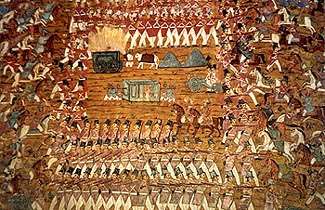 |
Training
Tipu's training in the art of war started as early as 1763, when he was
hardly 13 years old, in Haider's attack on Malabar where Tipu displayed great dash and
courage. That was his first experience of war. He was present in
Haider's negotiations with the Nizam in the First Mysore war when tact and resourcefulness
of the young prince impressed the Nizam and won him over to Haider's side. It was Tipu who
obtained the ratification of the Treaty of Alliance between the Nizam & Haider in
1767. Tipu had gone to the Nizam's Camp at the head of 6000 troops and successfully
concluded the treaty. This was the first diplomatic assignment of Tipu, who was well
received by the Nizam who conferred on him the title of "Nasib-ud-daula"
(fortune of the state) and also "Fateh Ali Khan".
A great victory
Tipu had taken great interest in the Mysore-Maratha war of 1769-72. After the
death of Peshwa Madhava Rao in 1772, he was sent to the northern part of Mysore to recover
the territories which the Marathas had occupied. By the time of Second Mysore war he had
gained great experience both of warfare and diplomacy. In September
1780 he inflicted crushing defeat on Colonel Baillie near Polilur. This
was the first and the most
|
serious blow the English had suffered in India.
The whole detachment was either cut or taken prisoners. Of the 86 European officers 36
were killed, and 3820 were taken prisoners of whom 508 were Europeans. The English had
lost the flower of their army. Baillie himself was taken prisoner. This defeat caused so
much consternation in Madras that
half of its Black Town was. |

Mural painting of Polilur Battle |
| deserted Sir Hector Munnroe, the
hero of Buxar, who had defeated three rulers of India (Mughal Emperor Shah Alam, Oudh
Nawab Shuja-ud-daula and the Bengal Nawab Mir Qasim) in a single battle, would not face
Tipu. He ran for his life to Madras throwing all his cannons in the tank of Conjeevaram. |
[ Table of Contents ] [ Go Top ] |

